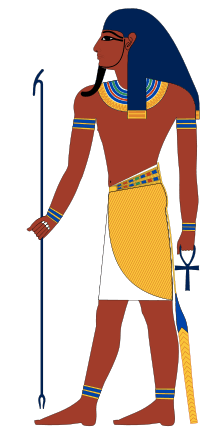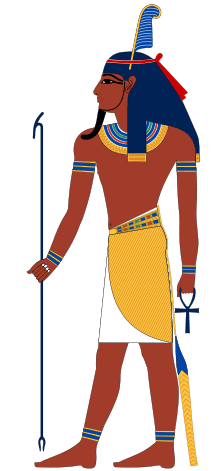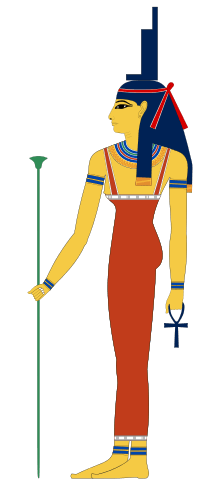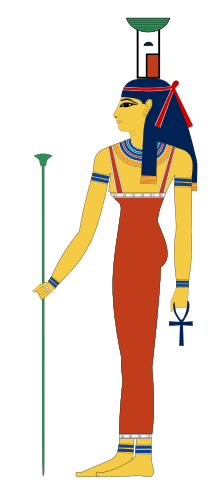Ennead
| ||||||||||
| The Ennead in hieroglyphs |
|---|
The Ennead (Ancient Greek: ἐννεάς, meaning "group of nine") was a group of nine deities in Egyptian mythology. The Ennead were worshipped at Heliopolis and consisted of the god Atum, his children Shu and Tefnut, their children Geb and Nut and their children Osiris, Isis, Set, and Nephthys.
Terminology
Egyptian mythology established multiple such groupings of deities, known as Pesedjets. The Pyramid Texts of the 5th and 6th dynasties mention the Great Pesedjet, the Lesser Pesedjet, the Dual Pesedjet, plural Pesedjets, and even the Seven Pesedjets. Some pharaohs established pesedjets that incorporated themselves among the deities. The most notable case is Seti I of the 19th dynasty, who in his temple at Redesiyah worshipped a pesedjet that combined six important deities with three deified forms of himself. Ennead may have represented Pleiades in the prognosis texts of the Calendar of Lucky and Unlucky Days of papyrus Cairo 86637.[1]
The Greek term Ennead, denoting a group of nine, was coined by Greeks exploring Egypt, its culture and religion, especially after the conquest by Alexander the Great and during the subsequent rule of the Ptolemaic Dynasty. Greek became the language of learned studies and hence Greek terms were used by Greek and Roman authors to describe Egyptian phenomena. These others also made use of parallels between Egyptian and Greek deities to identify the two.
Development of the Ennead
Among Egyptian pesedjets, the most important was the Great Pesedjet, also called the Ennead of Heliopolis, after its centre of worship. Heliopolis (Egyptian: Aunu, "Place of Pillars") was dedicated to the worship of the god Atum and thrived from the Old Kingdom until its decline under the Ptolemaic rulers.
The development of the Ennead remains uncertain. Egyptologists have traditionally theorised that the priesthood of Heliopolis established this pesedjet in order to stress the pre-eminence of the sun god above other deities, incorporating gods which had been venerated elsewhere for centuries while ignoring others. The most prominent of such deities was Osiris, god of vegetation and of the netherworld, who was incorporated into the Ennead as Atum's great-grandson. However, in the 20th century, some Egyptologists question the whole scenario.
What appears almost certain is that the Ennead first appeared when the cult of the sun god Ra, which had gained supreme ascendency during the 5th dynasty, declined during the 6th dynasty. After propagation of the Ennead, the cult of Ra - identified with Atum - saw a great resurgence until being superseded by the worship of Horus and the identification of the two as Ra-harakhty (Ra, who is Horus of the Two Horizons).
The Ennead faced competition by other groupings: At Memphis, the priests of Ptah identified their deity with the primeval mound, the place on which Atum arose first, giving him precedence over the Ennead.
Accounts of the Ennead
The creation account of Heliopolis relates that from the primeval waters represented by Nun, a mound appeared on which the self-begotten deity Atum sat. Bored and alone, Atum spat or, according to other stories, masturbated, producing Shu, representing the air and Tefnut, representing moisture. Some versions however have Atum—identified with Ra—father Shu and Tefnut with Iusaaset, who is accordingly sometimes described as a "shadow" in this pesedjet.
In turn, Shu and Tefnut mated and brought forth Geb, representing the earth, and Nut, representing the nighttime sky. Because of their initial closeness, Geb and Nut engaged in continuous copulation until Shu separated them, lifting Nut into her place in the sky. The children of Geb and Nut were the sons Osiris and Set and the daughters Isis and Nephthys, which in turn formed couples.
Gallery
References
- ↑ Jetsu, L.; Porceddu, S. (2015). "Shifting Milestones of Natural Sciences: The Ancient Egyptian Discovery of Algol's Period Confirmed". PLOS ONE. 10(12): e.0144140 (23pp). doi:10.1371/journal.pone.0144140.







